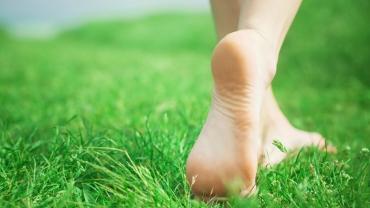
“Of all the paths you take in life make sure a few of them are dirt.”
~John Muir author naturalist
Sinking your bare toes into wet grass dirt sand or water is the latest trend in wellness. Known as “earthing” or “grounding” when skin comes into contact with the ground the human body becomes a sponge that soaks up negative electrons from the earth. This practice is quickly earning recognition as a novel way to protect your health and combat the insults of our current lifestyles.
The modern concept of earthing made its debut in 2010 with the release of Clint Ober’s book Earthing: The Most Important Health Discovery Ever? Nearly 12 years earlier Ober a retired pioneer of the American cable TV industry discovered that the same system of grounding used to stabilize telecommunications and wires could also stabilize the bioelectrical environment of the human body improving the function of all body systems.
Although we are just now understanding how earthing improves our health it has been practiced since the beginning of time when our ancestors walked around on bare feet or conductive leather moccasins or sandals. Perhaps this is one explanation for their longevity and good health. After the invention of rubber-soled shoes a non-conductive barrier was erected between mankind and our greatest source of electrons – the earth. As our direct contact with the earth fades through the routine use of synthetic flooring and shoes and our exposure to electromagnetic fields grows electromagnetic instability threatens our health.
Negatively charged electrons are necessary to neutralize the positively charged free radicals generated by inflammation cellular damage trauma stress and our toxic environments. Industrialization and our increasingly technological world has thrown us into the labyrinth of electromagnetic fields. The more we learn about the radiation caused by these fields the more concerned we become for our future health. An abundance of free radicals instable charges inflammation and immune activation are responsible for some of our most threatening chronic conditions such as cancer cardiovascular disease diabetes and autoimmunity.
Earthing has become an area of great interest because it may provide a simple inexpensive means by which most of us can combat these destructive forces. Nobel Prize winner Richard Feynman described an umbrella affect created when we “earth.” He claimed that grounding equalized the electronic potential between the body and the earth so the body becomes an extension of the earth’s magnetic field. This potential “cancels reduces and pushes away electrical fields from the body.”
Since this discovery initial pilot studies have found that grounding improves sleep normalizes cortisol rhythms reduces pain and stress shifts the autonomic nervous system from the sympathetic branch toward the parasympathetic branch increases heart rate variability speeds wound healing and reduces blood viscosity.
In a blinded pilot study of 60 subject suffering from sleep disturbances and chronic muscle and joint pain for at least six months grounding each night for one month produced a 74 to 100 percent improvement in quality of sleep feeling rested upon waking muscle stiffness and pain chronic back and joint pain and general well-being. Only three control subject reported improvement in any category. Grounding appears to normalize diurnal cortisol levels which improve sleep pain and stress.
New research efforts are seeking to understand how grounding affects the inflammatory response and the immune system. Positive influences on both systems could have far-reaching health benefits. We already know that grounding modulates cortisol and therefore can reduce systemic inflammation associated with glucocorticoid resistance that develops from chronic stress. The influx of free negative electrons from the earth also combats positively charged reactive oxygen species (ROS) generated by inflammatory factors neutrophils and lymphocytes in response to injury infection or trauma. Neutralized ROS leads to a decrease in neutrophils and lymphocytes and modulates the immune response. Healing proceeds at a faster rate in the absence of destructive ROS. On the other hand areas of electron deficiency are vulnerable to chronic tissue destruction leading to rises in ROS systemic inflammation and chronic immune activation. This environment increases risks for cancer autoimmunity infections and a general decline in health.
Grounding may also be beneficial for preventing cardiovascular disease. Occlusive artery disease is associated with a decrease in red blood cell surface charges because they promote RBC aggregation. Increasing the charges on the surface of RBCs (zeta potential) decreases aggregation. A study of 10 subjects grounded for 2 hours resulted in an increase in zeta potential by a factor of 2.7 which is highly statistically significant. Chronic elevation of cortisol and sympathetic activation are also risk factors for cardiovascular disease. Since grounding positively influences both factors this is more evidence for grounding being a preventative measure for heart disease.
There are many ways to encourage grounding. A plethora of grounding materials from sheets to shoes exist. However the most simple and inexpensive way for everyone to ground is to simply walk on the ground in your bare feet. Moisture is a superior conductor and therefore wet grass dirt a beach or lake provides the best grounding experience. It is also helpful to know that leather metal cotton and non-stained concrete are conductive. However pavement wood plastic rubber synthetic or insulated materials will block the healthful negative charges from balancing your bioelectrical field.